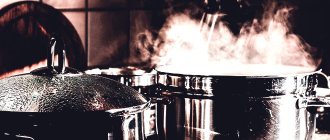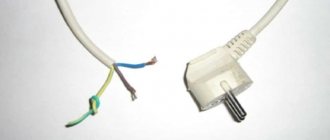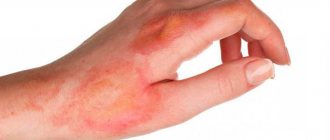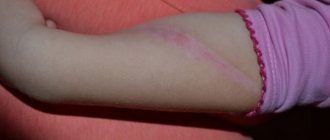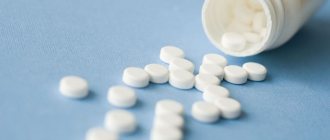You can treat 1st and 2nd degree burns on your own. With such injuries, the skin becomes red and blisters. Treatment of burns with blisters at home is carried out using folk remedies (baths, ointments, infusions) or special medications (creams, antiseptic sprays).
You can treat 1st and 2nd degree burns at home
What does a burn blister hide?
The bubble at the burn site, often called a blister, is dead skin that has begun to peel off as a result of exposure.
The human body has many protective mechanisms that save it from death.
The blister in this situation is a clear example of isolating damaged but viable skin from a layer that is already dead and can become a source of infection.
The fluid that accumulates in it is lymph, which protects the burn site from contact with the external environment, preventing pathogens from entering the body.
Important! The yellowish liquid contains a huge number of leukocytes - guardians of the immune system, killing everything foreign and dangerous. That is why blisters at the site of a burn cannot be pierced , much less cut off or removed independently.
The appearance of a bubble at the site of the burn, initially filled with a transparent and then gradually yellowing liquid, indicates the second degree of severity of the injury. The phenomenon is painful, but most often not dangerous if the burn is smaller than the palm of your hand, is not on the face or in the groin area, if the victim is not a child, an elderly person, or a patient suffering from diseases of the endocrine system, for example, diabetes.
Question answer
Is it possible to open a burn blister?
To pierce or not is the most common question among people who have received a small burn with blisters. Therefore, it is worth remembering the basic rule: you cannot open a blister yourself (even with a sterile medical needle).
You cannot open a burn blister yourself.
What happens if a burn blister bursts?
The bubble is a kind of protection for injured skin that is susceptible to pathogenic microflora. If it bursts, you can get a number of complications, among which the most common is wound suppuration. In addition, after opening the bubble, a scar may form on the skin, reminiscent of a burn.
If the bubble bursts, the wound may fester
When do blisters go away after a burn?
Taking into account the use of drugs, the blisters disappear within a few days. Without drug intervention, the blisters disappear on average within a week. With minor superficial damage, the blisters go away quickly and without complications.
If the affected person has a persistently elevated temperature (up to 38-39 degrees) that does not subside within 12 hours, then you should consult a doctor. The same must be done if pain increases on the second or third day after receiving a burn.
Thermal burns
- Cool the burn area with cold water.
Apply a cloth soaked in it, carefully pour water onto the damaged area, or simply lower it into a container of water. Under no circumstances should you use snow or ice ; such a temperature difference can lead to worse consequences, including frostbite and damage to large areas of the skin. - Then you need to gently blot with a soft cloth, gauze, or napkins to dry the skin.
- Treat the burn and the area around it with an antiseptic. Furacilin, a weak solution of potassium permanganate (potassium permanganate), and chlorhexidine are suitable. You can use hydrogen peroxide. Every home medicine cabinet has at least one of these products.
- Apply a thin layer of antibacterial ointment to the burned area and everything around it. Doctors recommend Levomekol, Bepanten. Olazol, the foam of which also has an analgesic effect, and Panthenol help well with second-degree burns.
- Cover the ointment with a sterile cloth, gauze, special anti-burn wipes soaked in special agents, bandage it or secure it at the site of injury.
- If the pain is very severe, you can take a pain reliever.
- Repeat the dressing after 4 - 6 hours, examining the burn site, carefully removing the layer of ointment, treating it with an antiseptic and lubricating it again.
Anti-burn products in pharmacies are presented in a wide range, so any pharmacist will tell you which one is best to use. We must remember that expensive does not mean the best; you need to choose based on the situation and individual characteristics.
You can get second-degree burns with blisters not only from contact with steam, hot liquids or objects. Marks on the body along with severe pain can leave chemical burns when in contact with acids or alkalis .
When can you start treatment?
Treating burns with blisters at home is fine if the area is small. There are only a few exceptions that require mandatory medical supervision .
- Burns to the hands and feet are dangerous because the resulting scars can partially disrupt the functions of these parts of the body.
- Burns of the groin area also require medical attention; injuries are extremely painful at any degree of damage, healing is slow, with complications.
- Facial burns not only lead to the formation of ugly scars. The eyes and mucous membranes suffer; only proper treatment under medical supervision will help to avoid extremely unpleasant and even irreversible consequences.
- The appearance of many small blisters next to each other: this may indicate deep damage to a large area of the body surface. The blisters will merge into one or several huge ones, which will easily burst and become infected.
In other cases, treatment can begin immediately after first aid.
How and with what to treat burn blisters at home?
If the blister is not destroyed, it is enough to apply ointments that relieve swelling and change sterile dressings twice a day.
When the germ layer of the skin is restored and a scar forms, the bubble will dry out and the dead skin will come off on its own.
If it was not possible to avoid damage to the blister, it is necessary to begin specific treatment aimed at preventing the development of the inflammatory process and the appearance of cracks during healing.
How to treat a burn with blisters at home? Treatment methods
Both official and alternative medicine have many treatment methods aimed at rapid pain relief and restoration of affected areas.
Pharmacy products
A pharmacist at any pharmacy will tell you which products are best to purchase so that your recovery goes without complications.
Bepanten is applied 2-4 times a day when changing sterile dressings until granulation - the appearance of new skin cells. Then the ointment is also applied several times a day, but bandages are no longer required.
Solcoseryl - ointment stimulates cell restoration, accelerates healing, and prevents infection.
Fastin - has shown excellent results in the treatment of 2nd degree burns, prevents the penetration of dangerous microorganisms into the wound, and has an analgesic effect.
Panthenol is one of the most popular remedies as an analgesic, anti-inflammatory, and promotes regeneration.
Buy at the pharmacy:
- Bandages at the rate of 2 packs of sterile material for every day.
- Chlorhexidine, hydrogen peroxide or any other antiseptic.
- Several pairs of gloves for dressings.
- Cotton swabs and gauze swabs for treating the wound and removing pus.
- Antibacterial ointments or gels (from those listed above or those recommended at the pharmacy.
- After treating your hands with an antiseptic and wearing gloves, carefully remove the sterile dressings from the victim.
- Apply peroxide or chlorhexidine to the skin around the blister.
- Use a cotton swab to gently remove fluid or pus if the blister is broken.
- Cover the wound site with a gauze swab containing medicine.
- Dress with sterile material or secure the bandage with a bandage.
Reference! You can also ask the pharmacy for special material for dressings for burns, long-healing wounds and ulcers.
They are not cheap, but they are much simpler: the wound is treated with an antiseptic, then a napkin soaked in antiseptics, balms that accelerate healing, or a special ointment dressing is applied to it, which slowly dissolves upon contact with the skin, absorbing into the wound.
Such materials are used in burn centers; they cause less trauma to the skin during dressings, do not dry out, and make procedures much easier.
Folk remedies for burns with blisters
There are also ways to overcome pain and scarring after the appearance of a blister in traditional medicine. As a rule, everything for them is at hand in every home.
- Raw potatoes: wash thoroughly, peel, cut into slices. Apply each to the affected area for 5 - 7 minutes, this will relieve pain and can prevent the appearance of blisters. And even if they appear, potatoes will “draw out” heat and inflammation.
- Starch also has a healing and analgesic effect. Mix 3 - 4 tablespoons of powder with 1 spoon of water, apply this paste to the reddened area and blister. After 2 - 3 hours, rinse, treat with an antiseptic and reapply the freshly prepared mixture.
- Carrot compress: grate on a fine grater, place on a sterile cloth (if necessary, iron a towel, sheet, T-shirt or shirt), apply to the sore spot. Change every 2 – 4 hours.
- Baking soda: it is taken to sprinkle the burn area, which even helps to avoid peeling and quickly relieves pain. It is diluted with water to a paste and applied to the wound if the blister has not burst.
- Cabbage is a great heat reliever. Fresh leaves are applied to the burn site, fixing as tightly as possible. Change the sheets every 3 to 4 hours as they dry.
- Aloe - the healing power of the plant is well known. For burns, take a young flower leaf from the windowsill, cut it in half along the leaf, and apply the cut side to the burn. You can also chop the leaf, squeeze out the juice and soak a gauze pad in the juice, which is then placed on the wound.
- Sea buckthorn oil is indispensable for such injuries. They lubricate the sore spot every 5–6 hours, covering it with sterile bandages.
- Peppermint is used both fresh and in decoctions. Freshly picked leaves are applied to swelling and redness to relieve pain and heat. Decoction of 2 tbsp. dry leaves per 1 tbsp. boiling water is mixed with 0.5 tbsp. olive or other vegetable oil. The resulting mixture is first impregnated with gauze swabs, used for dressings, and then it is simply lubricated with the healing burn.
- Lily is a stunningly beautiful flower, which also improves immunity, relieves inflammation and swelling. Several buds along with stems need to be filled with 1 tbsp. unrefined vegetable oil, leave for 2 weeks in a dark place and then store in the refrigerator. Apply as a gel for burns several times a day. Will help with long-term non-healing wounds.
- Egg – immediately after a burn, beat the egg white and gently apply to the swelling. Leave for 6 hours, then rinse and reapply ointment. You can beat the egg completely, mix with vegetable oil and lubricate the injury site every 2 hours until the pain goes away.
- Linden decoction, when 1 tbsp. boiling water take 1 tbsp. l. dried flowers, used for compresses and washes.
- It is good to sprinkle the burn area with powder from dried and crushed dry pomegranate peel. This powder speeds up healing significantly.
- An ointment made from Vaseline and calendula tincture is more effective than some medications. Mix 1 tbsp. l. tinctures with 5 tbsp. Vaseline, carefully lubricate every 4 hours.
- Tea will help quickly relieve pain and swelling.
Apply green or black tea bags soaked in warm water to the affected area. Wash the wounds with freshly cooled tea leaves. - You can apply a raw peeled onion, or grated pumpkin, or beet leaves, or burdock leaves to the burn.
- Oak bark compresses: 1 tbsp.
raw materials are boiled in 2 tbsp. water 30 min. Then gauze swabs are soaked in the broth and applied, constantly changing. - A mixture of rhubarb and honey, mixed in equal parts, will quickly make the blister go away if you apply the compress 4 times a day, covering it with a sterile bandage.
Possible adverse reactions
When using the drug Sinaflan, the following are rarely possible:
- increased itching, flaking, dry skin;
- the appearance of keratosis;
- swelling, redness, burning.
With long-term use, there are isolated cases of impaired carbohydrate metabolism, increased blood pressure, and decreased immunity. The risk of side effects is higher when Sinaflan is combined with other hormonal ointments or when taking systemic glucocorticoid drugs.
Burn blisters - home treatment and what not to do
There are several popular beliefs about miraculous remedies that can help almost instantly. Unfortunately, they are extremely dangerous for second-degree burns and more severe, and can lead to irreversible consequences, so it is worth remembering that you cannot :
- treat the burn site with any fat, fat-containing creams and gels, which, when dry, form a crust that restrains heat; pathogenic bacteria also multiply under it;
- pierce or cut off the blister yourself (only in case of emergency, piercing on the side with a sterile needle is allowed at home to cause the outflow of accumulated fluid;
- without the help of a surgeon, cut off the exfoliated skin on a very large blister; wounds of this size, not covered by skin, require particularly careful treatment with special preparations; areas with an exposed bright red painful surface, if the blister is accidentally opened, are best covered with ointment napkins until medical assistance is provided;
- treat the injury site with alcohol, which deprives the tissue of the remaining fluid;
- rub ointments and creams into the injured area, it is best to use a spray or foam, and then cover with a sterile bandage;
- treat with urine - in the old days this method was practiced, but even then only children’s urine was used. Urine contains corticosteroids that relieve inflammation, but there are few of them, but there are many more causative agents of various diseases.
Attention! You shouldn’t listen to “experienced advice” and treat yourself with everything that comes to mind. Many techniques have been developed to treat any burns of any severity, which will save you from infection, pain and the formation of spots and scars.
If you decide to be treated at home, you need to carefully listen to the doctor’s recommendations, constantly consult with him and seek urgent help if the swelling increases, the wound begins to emit an unpleasant odor, does not heal for a long time, and the body temperature rises.
Contraindications
Sinaflan should not be used for the following skin pathologies:
- for mechanical damage to the integument: wounds, abrasions, ulcerative processes;
- when tissues are damaged by viruses, fungi, bacteria, herpes and other infectious agents;
- for skin tuberculosis;
- benign and malignant neoplasms: including on the surface of birthmarks and moles.
Hormonal ointment should not be used for application to the mucous membranes of the eyes, mouth, or nipple halos. It is undesirable to treat formed psoriatic plaques with clearly disturbed epithelial structure. This drug should also not be used for acne and inflammatory nodules of unknown origin, demodicosis. The glucocorticoid in its composition can provoke further skin damage, aggravating the clinical picture.
You will also have to exclude parking during pregnancy and lactation, since the hormone can cause unwanted reactions in the child’s body.
